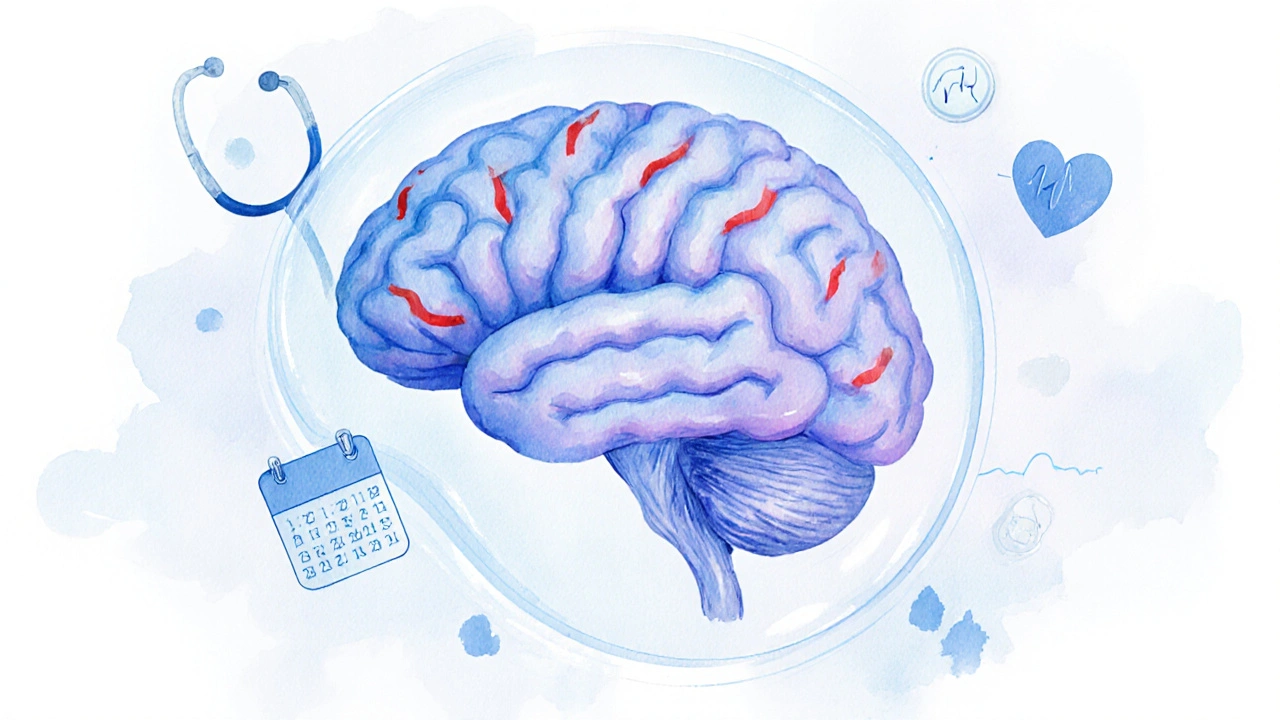TIA Risk Assessment Calculator
Fill in the form below to assess your risk of experiencing a Transient Ischemic Attack (TIA).
Age
Gender
Blood Pressure (mmHg)
Cholesterol Level (mg/dL)
Diabetes Status
Smoking Status
Physical Activity (hours/week)
Quick Takeaways
- TIAs are warning signs; catching them early can stop a full‑blown stroke.
- Blood pressure, cholesterol, and diabetes are the top modifiable risk factors.
- Annual vascular screening (carotid ultrasound, MRI) catches silent blockages.
- Adults over 40 should schedule a comprehensive check‑up at least once a year.
- Combine medical monitoring with lifestyle tweaks for maximum protection.
Imagine a traffic light flashing amber just before a crash. That flash is what doctors call a Transient Ischemic Attack is a brief, reversible interruption of blood flow to the brain that typically lasts under 24hours. While the symptoms fade, the underlying vessels may already be on a dangerous path toward a full stroke. Getting regular checkups is the best way to keep a watchful eye on Transient Ischemic Attack risk and act before the light turns red.
What Exactly Is a Transient Ischemic Attack?
A Transient Ischemic Attack (TIA) is a short‑lasting neurological deficit caused by a temporary blockage in a cerebral artery. The blockage dissolves quickly, so symptoms-like sudden weakness, slurred speech, or vision loss-go away on their own. Because the brain recovers fully, many people dismiss the episode as a ‘mini‑stroke’ and skip medical follow‑up. In reality, studies from the British Stroke Association show that up to 40% of people who experience a TIA will suffer a major stroke within the next five years if no preventive action is taken.
Why Early Detection Saves Lives
TIAs act as red flags for vascular disease. When a clinician spots a TIA, they can investigate the arteries, blood composition, and lifestyle factors that led to the blockage. Early detection lets doctors start antiplatelet therapy, adjust blood‑pressure meds, or schedule surgical interventions before a stroke locks the damage in place. In a 2023 trial involving 2,500 patients, those who received a comprehensive assessment within 48hours of a TIA had a 30% lower chance of stroke compared with those who waited longer.
Key Health Markers That Signal Danger
Regular checkups focus on measurable risk factors. Below are the five markers most strongly linked to TIA and stroke.
- Blood Pressure is the force of blood against arterial walls. A reading above 140/90mmHg markedly raises the odds of a TIA.
- Cholesterol-especially high LDL-feeds plaque buildup in brain‑feeding arteries.
- Diabetes accelerates atherosclerosis, making tiny clots more likely.
- Atherosclerosis describes the hardening and narrowing of arteries, the root cause of most TIAs.
- Inflammatory Markers such as C‑reactive protein (CRP) can indicate unstable plaques that might rupture suddenly.

Standard Screening Tools You Should Expect
When you walk into a clinic for a TIA‑focused checkup, doctors typically order a mix of imaging and blood tests. Below is a side‑by‑side look at the most common tools.
| Screening Tool | What It Detects | Typical Frequency | Key Advantage |
|---|---|---|---|
| Carotid Ultrasound | Plaque buildup in carotid arteries | Every 1-2years for high‑risk patients | Non‑invasive, no radiation |
| Magnetic Resonance Imaging (MRI) | Silent brain infarcts, vessel narrowing | Every 2-3years or after a TIA event | High‑resolution detail of soft tissue |
| Blood Panel | Cholesterol, fasting glucose, CRP, coagulation profile | Annually | Provides multiple risk markers in one draw |
| Electrocardiogram (ECG) | A‑fib or other arrhythmias that can send clots to the brain | Every 1-2years or after TIA | Quick, inexpensive |
How Often Should You Schedule Each Checkup?
There isn’t a one‑size‑fits‑all calendar, but guidelines from the National Institute for Health and Care Excellence (NICE) suggest the following baseline schedule:
- Age40‑55 with no risk factors: Full vascular screen every 3years.
- Age55+ or any of the five key markers elevated: Annual comprehensive review.
- After a confirmed TIA: Follow‑up within 48hours, then at 1month, 3months, and 6months. Imaging is repeated at the 6‑month mark.
- Patients on Antiplatelet Therapy (e.g., aspirin or clopidogrel) need platelet function testing every 12months.
These intervals can be tightened if you have a family history of early stroke, uncontrolled hypertension, or persistent high LDL.
Lifestyle Tweaks That Amplify Medical Checks
Medical screening catches problems early, but lifestyle choices determine whether those problems progress.
- Follow a Mediterranean‑type diet-rich in olive oil, nuts, fish, and leafy greens-to lower LDL by up to 15%.
- Aim for 150minutes of moderate aerobic activity weekly; cardio fitness reduces systolic pressure by roughly 5mmHg.
- Quit smoking; each cigarette adds about 2mmHg to your blood pressure instantly.
- Limit alcohol to two units per day; excess intake spikes triglycerides and blood pressure.
- Manage stress with mindfulness or brief daily walks; cortisol spikes can trigger temporary vascular constriction.
Common Pitfalls and How to Avoid Them
Even with the best intentions, some habits sabotage prevention efforts.
- Skipping appointments because you feel fine. TIAs can be silent-use a calendar reminder.
- Assuming “normal” test results mean zero risk. Plaque can develop between screenings; stay vigilant.
- Relying on over‑the‑counter supplements alone. While omega‑3s help, they don’t replace prescribed antihypertensives.
- Ignoring medication side‑effects and stopping drugs abruptly. Always discuss changes with your GP.
Next Steps: Building a Personalized TIA Prevention Plan
Take the information you’ve just read and translate it into a concrete action list:
- Book a full vascular review with your GP or a local stroke clinic.
- Ask for a Carotid Ultrasound and baseline blood panel.
- Write down current numbers (BP, LDL, HbA1c) and set target goals with your doctor.
- Set a reminder on your phone for annual check‑ups and half‑yearly imaging if a TIA occurred.
- Implement at least two lifestyle changes from the list above and track progress weekly.
Remember, a TIA is a warning, not a destiny. Regular checkups turn that warning into a chance to rewrite your vascular future.

Frequently Asked Questions
Can a TIA happen without any noticeable symptoms?
Yes. Some TIAs are "silent" and only show up on imaging. That’s why routine scans are vital for high‑risk individuals.
How soon after a TIA should I see a doctor?
Ideally within 48hours. Early evaluation dramatically cuts the chance of a subsequent stroke.
Is Carotid Ultrasound painful?
No. It uses harmless sound waves and feels like a gentle massage on the neck.
Do I need medication even if my scans are clear?
Your doctor may still prescribe low‑dose aspirin or another antiplatelet if you have other risk factors like high blood pressure or diabetes.
What lifestyle change gives the biggest risk reduction?
Quitting smoking tops the list, followed closely by controlling high blood pressure through diet, exercise, and medication.

Ashley Allen
September 29, 2025 AT 23:22Regular checkups give doctors a chance to spot early warning signs and adjust treatment plans.
Staying on top of your health can keep a TIA from becoming a full‑blown stroke.
Brufsky Oxford
October 1, 2025 AT 03:09When we view health as a continuous dialogue, preventive visits become moments of self‑inquiry.
Each appointment invites us to question how daily habits shape vascular resilience 🙂.
Reflecting on those answers can empower us to make smarter lifestyle choices.
VAISHAKH Chandran
October 2, 2025 AT 06:56Our blood vessels reflect the strength of our nation they deserve rigorous monitoring and regular checkups to ensure that the nation’s heart beats strong.
Pat Merrill
October 3, 2025 AT 10:42Oh sure, because nobody ever forgets to eat fast food and skip exercise, right?
But if you actually take a moment to think about it, the science is pretty clear – early detection beats regret every time.
definately worth the time.
Vicki Roth
October 4, 2025 AT 14:29I schedule my checkup every year, no excuses.
Vishal Bhosale
October 5, 2025 AT 18:16Checkups are good but the process feels like a waste of time.
Garima Gauttam
October 6, 2025 AT 22:02Everyone claims early detection is key yet they ignore the everyday choices that truly matter.
Georgia Nightingale
October 8, 2025 AT 01:49Oh the drama! We parade around with glossy risk calculators while the real battle is fought on our kitchen tables.
The truth is, no app can replace a heartfelt conversation with a doctor.
Chris Kivel
October 9, 2025 AT 05:36I’ve seen friends avoid a mini‑stroke simply because a routine visit caught high blood pressure early.
It’s a small habit that can save big lives.
Fredric Chia
October 10, 2025 AT 09:22The presented risk calculator lacks statistical validation and should not be relied upon for clinical decisions.
Julia Odom
October 11, 2025 AT 13:09Taking charge of your vascular health starts with a simple appointment, but the ripple effect can be astonishing.
When you sit down with a clinician, you receive personalized feedback that no generic website can match.
That feedback often uncovers silent hypertension, a hidden cholesterol surge, or a pre‑diabetic trend.
Each of these silent threats, if left unchecked, can set the stage for a transient ischemic attack.
Regular monitoring empowers you to adjust medication dosages before they become hazardous.
It also provides a motivational boost, reminding you that proactive steps are yielding measurable results.
Moreover, the doctor‑patient conversation can highlight lifestyle tweaks-like adding an extra walk or swapping fried foods for berries.
These modest changes compound over months, building a resilient vascular system.
Research consistently shows that patients who attend annual checkups have a markedly lower incidence of TIA and stroke.
Early detection not only saves lives but also slashes long‑term healthcare costs.
Imagine avoiding a hospital stay, a family’s worry, and the disruptive recovery that follows a stroke.
That peace of mind is priceless and begins with a calendar reminder.
If you ever feel complacent, remember that health is a marathon, not a sprint.
Every routine visit is a checkpoint, a chance to recalibrate your course.
So set that alarm, book the slot, and walk into your appointment with confidence.
Your future self will thank you for the dedication you show today.